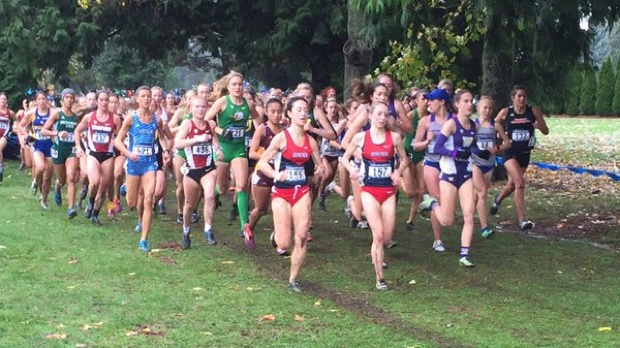The NCAA 'May' Have Made a Mistake With Qualifying System
The NCAA 'May' Have Made a Mistake With Qualifying System



By David Everett
The NCAA Division I qualifying system for cross country has a detailed list of rules, ones meant to take subjectivity out of the equation. The rules were put to the test on Friday. With very few teams beating the top 22 teams, and tons of teams getting a point off Texas--the Longhorns were 40th at Pre-Nationals--the potential field was flooded with teams with one “point.”
A point comes from beating a team that already is qualified for the national championship, starting with the 18 automatic bids (two from each region). You then take the team with the most points. After each team is selected, points are recalculated.
At any given time, the only teams being considered are the top two teams from each region that are not already qualified. Those teams are considered by three levels of criteria, in order.
1. Points. This will do the trick most of the time--Team A has four points, no one else has more than three-- but in case it doesn’t...
2. Head-to-head competition among the remaining teams. It is important to note that in this second criterion, it does not matter how many wins you have, but how many losses. If Team A is 5-1 and Team B is 1-0, Team B is selected.
3. Win/Loss vs. Common Opponents. While this does play out in one possibility, for simplicity sake let’s pass on this for now.
1. Points. This will do the trick most of the time--Team A has four points, no one else has more than three-- but in case it doesn’t...
2. Head-to-head competition among the remaining teams. It is important to note that in this second criterion, it does not matter how many wins you have, but how many losses. If Team A is 5-1 and Team B is 1-0, Team B is selected.
3. Win/Loss vs. Common Opponents. While this does play out in one possibility, for simplicity sake let’s pass on this for now.
There is one more occurrence that needs explaining.
The push. If Team A has the most points of the 18 teams under consideration but lost to Team B at regional competition, Team B goes in followed by Team A
The push. If Team A has the most points of the 18 teams under consideration but lost to Team B at regional competition, Team B goes in followed by Team A
Let’s pick up this year’s NCAA women’s field at spot #23. Flotrack’s Kolas Calculator had just put BYU in at spot 22. No differences have arisen to this point. Of the 18 teams being considered at this time, nine of them have exactly one point. Under the rules, the next step is to take the nine teams tied to the second level of a tie-breaker: head-to-head competition.
Two teams are being put in under different systems: Princeton or San Francisco via a push from Gonzaga. Princeton is 5-0 against the eight other teams with a point that are currently in consideration. Gonzaga, having never competed at a big meet all season, has only seen San Francisco from the list. Gonzaga was able to squeak by them at conference by four points but lost to them at Regionals.
To the rulebook!
There are two rules which would point to Gonzaga not getting in under the current rulebook.
Rule 1: The time frame: “In order to maintain seven competition opportunities, the head-to-head competitions must have taken place between the seventh weekend before the NCAA regional meet (i.e., Friday, Saturday and Sunday, Sept. 25-27, 2015) through the conclusion of NCAA Regional Cross Country Championships (scheduled for Nov. 13, 2015)” --Section 2.4, Part 2A (pg.15 )
The time frame would suggest that head-to-head records count at regional meets as it states through the conclusion of Regionals. If that was the case Gonzaga is 1-1. The 1-1 record triggers the vaguest of rules.
Rule 2: “In situations where the head-to-head wins and losses are equal between teams under consideration (e.g., two teams with 1-1 or 2-2, etc., records against each other), the committee may give greater consideration to the competition conducted closest to the regional championship date.” --Section 2.4, Part2B (pg. 15)
The NCAA has an incredibly vague rule when deciding tie breakers between teams who have an evenly matched record. To their credit, this rule doesn’t get used, particularly at this level, very often. The way I see it, the committee might or might not take the team who has the victory closest to Regionals when considering two teams with an evenly matched record for the given time period.
There are three outcomes. The first is you rule that the meet closest to Regionals is Regionals, moving Gonzaga’s head to head record to 0-1 which results in Gonzaga and San Francisco not qualifying. Second, you could say the meet closest to Regionals isn’t Regionals, resulting in Gonzaga being 1-0 and pushing in San Francisco at 23. Third, the committee decides to go rogue with the “may” clause, saying that Gonzaga’s season record against San Francisco is 1-0, also resulting in Gonzaga and San Francisco heading to Louisville.
If you assume that Regionals is more important than a conference meet, Wisconsin and Purdue would swap places with the two teams in question. Under that assumption, San Francisco would be the first team out coming in at spot 32, entering without a push with Gonzaga following at 33.
With the official entries out, San Francisco has advanced through a push from a team’s win/loss record being spotless against eight other teams including a team they had lost to at Regionals.
It’s a messed up system. There is no one that would say that the best teams advance in the current infrastructure. That’s not to say that San Francisco and Gonzaga don’t deserve to be on the line at Nationals.
For those who want to dig deeper into that tie-breaker: there are nine teams at spot 23 with one point: Weber State, Brown, San Francisco, Gonzaga, William and Mary, Michigan State, Princeton, Villanova, and Minnesota.
Taking the nine teams with a point and looking at head-to-head
Weber State: 3-2 (Wins over Brown, San Francisco, and Villanova, Lost to Minnesota and Michigan State)
Brown: 0-4 (lost to Weber State, San Francisco, Princeton, and Villanova)
San Francisco: Without Gonzaga 1-4 (Win over Brown, Lost to Weber State, Michigan State, Villanova, Minnesota) Lost to Gonzaga at Conference but beat them at Regionals
Gonzaga: 0-0 among teams outside of San Francisco. Victory over San Francisco at Conference, Lost to them at Regionals.
William and Mary: 0-4 (Lost to Michigan State, Princeton, Villanova, Minnesota)
Michigan State: 4-1 (Wins over Weber State, San Francisco, William and Mary, Minnesota, Lost to Princeton)
Princeton: 5-0 (Wins over Brown, William and Mary, Michigan State, Villanova, Minnesota)
Villanova: 3-2 (Wins over Brown, San Francisco, William and Mary, lost to Weber State and Princeton)
Minnesota: 3-2 (Wins over Weber State, San Francisco, William and Mary, Lost to Michigan State and Princeton)